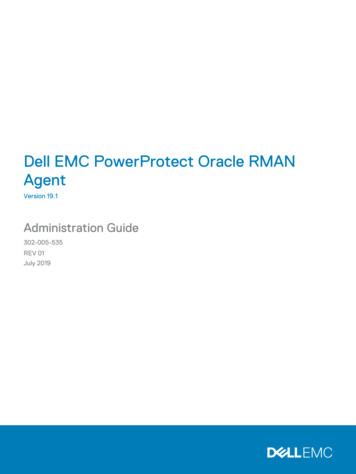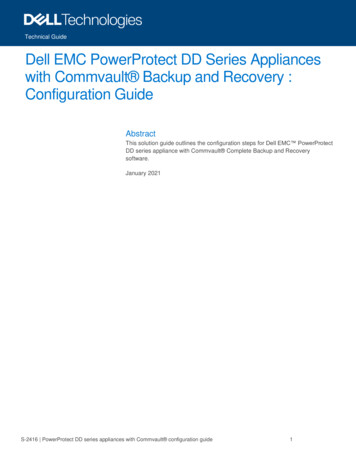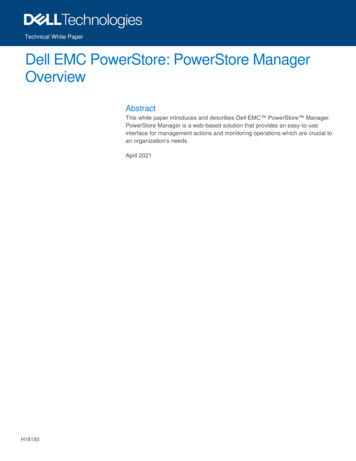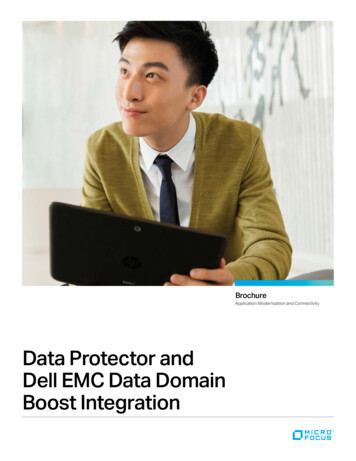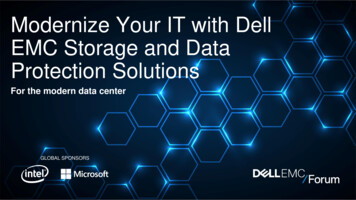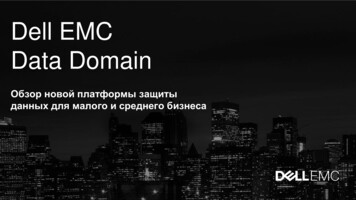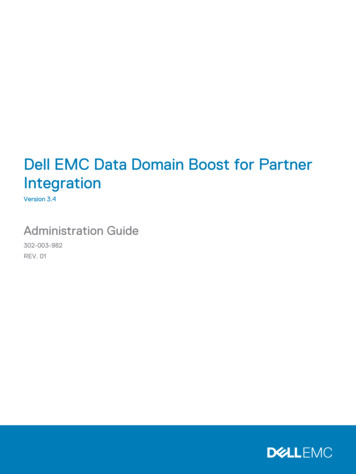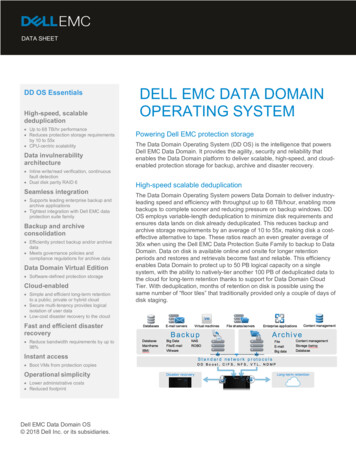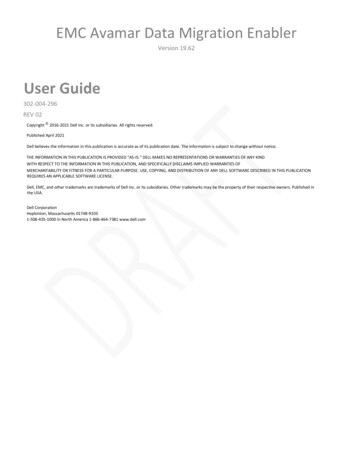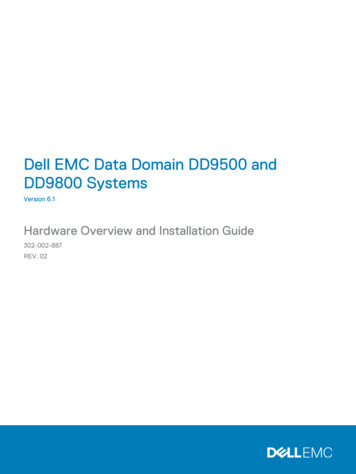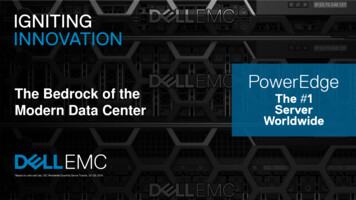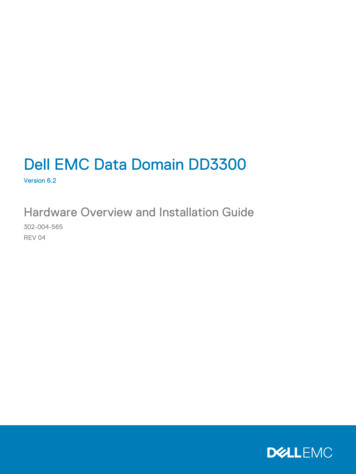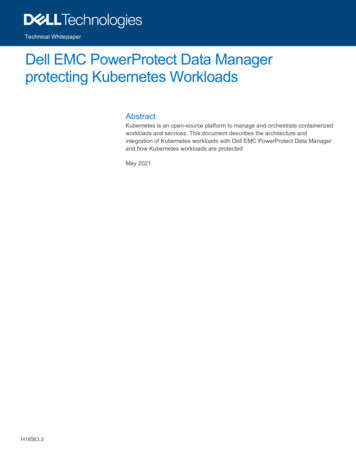
Transcription
Technical WhitepaperDell EMC PowerProtect Data Managerprotecting Kubernetes WorkloadsAbstractKubernetes is an open-source platform to manage and orchestrate containerizedworkloads and services. This document describes the architecture andintegration of Kubernetes workloads with Dell EMC PowerProtect Data Managerand how Kubernetes workloads are protectedMay 2021H18563.3
RevisionsDateDescriptionOctober 2020Initial releaseJanuary 2021Dell EMC PowerProtect Data Manager 19.6 Updates February 2021Dell EMC PowerProtect Data Manager 19.7 Updates May 2021PostgreSQL High AvailabilityCassandra Application Consistent ProtectionRestore Cluster Scoped ResourcesVMware Tanzu Kubernetes Cluster protectionDell EMC PowerProtect Data Manager 19.8 Updates Storage Class MappingAcknowledgementsAuthor: Abhishek Shukla, Sr. Engineering Technologist, Data Protection DomainThe information in this publication is provided “as is.” Dell Inc. makes no representations or warranties of any kind with respect to the information in this publication,and specifically disclaims implied warranties of merchantability or fitness for a particular purpose.Use, copying, and distribution of any software described in this publication requires an applicable software license.Copyright 2021 Dell Inc. or its subsidiaries. All Rights Reserved. Dell Technologies, Dell, EMC, Dell EMC and other trademarks are trademarks of Dell Inc. or itssubsidiaries. Other trademarks may be trademarks of their respective owners. [03-May-21] [Technical Whitepaper] [H18563.3]2Dell EMC PowerProtect Data Manager protecting Kubernetes Workloads H18563.3
Table of contentsRevisions. 2Acknowledgements . 2Table of contents . 3Executive summary . 5Audience . 5Scope . 51Introduction . 61.1 Features of Kubernetes . 61.2 Capability of Dell EMC PowerProtect Data Manager for Kubernetes . 61.2.1 Efficient and Flexible . 61.2.2 Built for Kubernetes . 61.3 Key components of PowerProtect Data Manager . 71.3.1 Cloud Native Data Manager (CNDM) . 71.3.2 PowerProtect controller . 71.3.3 VMware Velero . 71.3.4 cProxy (Containerized Proxy) . 71.4 Key Components of Kubernetes . 71.4.1 Cluster . 71.4.2 Node . 71.4.3 Pods and containers . 71.4.4 Kubernetes API (kube-apiserver) . 81.4.5 Persistent Volume (PV) and Persistent Volume Claim (PVC) . 81.4.6 Container Storage Interface (CSI) . 81.4.7 Storage Class . 81.4.8 Namespaces . 81.4.9 Custom Resources (CR) . 92Deployment Methods of Kubernetes .102.1 Kubernetes On-Premises .102.1.1 Kubernetes running on virtual environment .102.1.2 On-premises Kubernetes on bare metal .102.1.3 Using External CSI .112.2 Kubernetes on Cloud .112.2.1 Kubernetes deployed on Infrastructure as a Service (IaaS) .112.2.2 Kubernetes as a Service (KaaS) .1133Reference Architecture .12Dell EMC PowerProtect Data Manager protecting Kubernetes Workloads H18563.3
3.1 Protection of Kubernetes clusters .123.2 Protection of VMware Tanzu Kubernetes Grid (TKG) .134Configuring PowerProtect Data Manager protecting Kubernetes Workloads .144.1 Asset Discovery .144.2 Backup configuration .154.2.1 General Configuration .154.2.2 Kubernetes MySQL Application Consistent protection.174.2.3 Kubernetes PostgreSQL Application Consistent Protection .184.2.4 Kubernetes Cassandra App Consistent Protection .194.3 Restore Configuration .194.3.1 Restore to alternate cluster .194.3.2 Restore using Storage Class Mapping .214.3.3 Restore Cluster Scoped Resources .23ATechnical support and resources .25A.14Related resources.25Dell EMC PowerProtect Data Manager protecting Kubernetes Workloads H18563.3
Executive summaryTraditionally, Organizations used physical servers to run applications on. There was no way to defineresource boundaries for applications in a physical server, and this caused resource allocation issues. As asolution, Virtualization was introduced. It allowed to run multiple Virtual Machines (VMs) on a single physicalserver’s CPU. It also allowed applications to be isolated within VMs and provided a level of security.Modern infrastructure is being transformed by Containers. Containers are similar to virtual machines buthave relaxed isolation properties to share the operating system. The Container has its own filesystem, CPU,memory and process space. Agile application creation, continuous development, environmental consistencyacross development, application-centric management, efficient resource allocation and resource isolationare the key benefits of containers. Kubernetes is an open-source container management platform that unifiesa cluster of machines into a single pool of compute resources.With currently distributed container deployment, it is important to protect the workloads. Dell EMCPowerProtect Data Manager protects the Kubernetes workloads and ensures high availability, consistent,and reliable backup and restore for Kubernetes workload or DR situation. PowerProtect Data Manager offerscentralized management, automation, multi-cloud options and advanced integration for ease and simplicityfor managing workloads.AudienceThis white paper is intended for customers, partners, and others who want to understand how PowerProtectData Manager Software helps protect Kubernetes workloadsScope51. Dell EMC PowerProtect Data Manager version 19.82. Kubernetes (version 1.6 and above)Dell EMC PowerProtect Data Manager protecting Kubernetes Workloads H18563.3
1IntroductionThe Cloud Native definition is an architectural philosophy for designing the applications and infrastructure‘Containers’ provide a way to package and run the application. To run such applications, containerorchestrator is required. Kubernetes is an open-source container orchestrator for managing containerizedworkloads and services, that facilitate both declarative configuration and automation. It is portable, extensible,and scalable and has a large, rapidly growing ecosystem. Kubernetes services, support, and tools are widelyavailable.Dell EMC PowerProtect Data Manager protects existing as well as new discovered workloads. It allows IToperations and backup admins to manage Kubernetes clusters and its protection through a singlemanagement UI and define protection policies for Kubernetes workloads from Kubernetes APIs. The policydriven protection is defined by the Protection Policy mechanism. PowerProtect Data Manager discovers thenamespaces, labels, and pods in the environment and can be protected by providing cluster credentialsLogging, Monitoring, governance, and recovery are done through PowerProtect Data Manager1.1Features of KubernetesKubernetes is an open-source system for automating deployment, scaling and management of containerizedapplications Kubernetes automates Linux container operations and eliminates many of the manual processes involvedin deploying and scaling containerized applications Applications can be clustered together in group of hosts running Linux containers, andKubernetes helps you easily and efficiently manage those clusters. Kubernetes is an ideal platform for hosting cloud-native applications that require rapid scaling1.2Capability of Dell EMC PowerProtect Data Manager for Kubernetes1.2.1Efficient and FlexiblePowerProtect Data Manager provides enterprise-level protection for Kubernetes 1.2.2Built for Kubernetes 6Single Platform for Data Protection – PowerProtect Data Manager manages different workloads that isVMs, applications, and the containers through one platform.Protection to deduped storage allows great TCO with PowerProtect DD series.PowerProtect Data Manager allows flexible protection for Kubernetes clusters using the KubernetesAPIs.PowerProtect Data Manager discovers, monitors, and protects Kubernetes resources – namespaces,labels, pods, persistent volumesNo need to install a backup client container for each pod for backup processProvides protection to controllers per node to avoid cross-node traffic.Application Consistency for MySQL and MongoDB databasesRestore assets to another cluster that is connected to PowerProtect Data ManagerProtection for AWS hosted Kubernetes clusters using PowerProtect Data Manager running on AWS andprotected to PowerProtect Data Domain running on AWSDell EMC PowerProtect Data Manager protecting Kubernetes Workloads H18563.3
1.3Key components of PowerProtect Data Manager1.3.1Cloud Native Data Manager (CNDM)1.3.2PowerProtect controller1.3.3VMware VeleroThe Cloud Native Data Manager (CNDM) is in-built microservice component of PowerProtect Data Managerwhich communicates with the kube-apiserver of the cluster. This component is responsible for APIs for thebackup and restore process.PowerProtect controller is the component which gets installed on Kubernetes cluster when the cluster getsdiscovered by PowerProtect Data Manager. The backup and restore controllers that manager BackupJob CRand RestoreJob CR definitions. This component is responsible for the backup and restore of PersistentVolumes.VMware Velero is the open-source tool which is integrated with PowerProtect Data Manager. It is in-built anddoes not require to be installed separately. Velero component is pushed into the Kubernetes cluster by thePowerProtect controller pod after the same is in up and running state via velero deployment object. It isresponsible for the backup and restore of metadata.1.3.4cProxy (Containerized Proxy)1.4Key Components of Kubernetes1.4.1Cluster1.4.2Node1.4.3Pods and containers7The cProxy is stateless containerized proxy which gets installed on the Kubernetes cluster when the backupand restore process initiated and gets deleted once the process is completed. It is responsible for managing.Persistent Volume snapshots (snap copies), mounting snapshots and moving the data to the target storage.It is also responsible for restoring data into Persistent Volume from target storage and making the dataavailable for attaching to Pods. Also, agent plugin orchestrator for application aware backups.A Kubernetes Cluster is defined as group of machines called nodes that run containerized applications andhas a desired state that defines which applications or workloads should be running. The cluster’s desiredstate is defined with the Kubernetes API.A Node is defined for virtual or physical machine, depending on the cluster. Each node contains the servicesnecessary to run pods and is managed by the master components. There are two kinds of Nodes: MasterNode and Worker NodePods operate at one level higher than individual container. Multiple containers can be encapsulated within aPod. A Kubernetes pod is defined as a group of containers that are deployed together on the same host.The Pod is sometimes called as container when a single container is frequently deployed.Dell EMC PowerProtect Data Manager protecting Kubernetes Workloads H18563.3
1.4.4Kubernetes API (kube-apiserver)1.4.5Persistent Volume (PV) and Persistent Volume Claim (PVC)The Kubernetes API server is control plane of the Kubernetes cluster that exposes the Kubernetes API. Itserves as the foundation for the declarative configuration schema for the system. The kubectl commandline tool can be used to create, update, delete, and get API objects.Persistent Volume is a storage defined for the cluster that is provisioned by an administrator or dynamicallyprovisioned using Storage Classes (SCs). It is a resource in the cluster similar to a node. PVs are volumeplugins like Volumes but have a lifecycle independent of any individual Pod that uses the PV. It captures thedetails of the implementation of the storage that is NFS, iSCSI, or a cloud-provider-specific storage systemA Persistent Volume Claim (PVC) is a request for storage by a user. It is like a Pod. Pods consume noderesources. Similarly, PVCs consume PV resources. Pods can request specific levels of resources (CPU andMemory).1.4.6Container Storage Interface (CSI)1.4.7Storage Class1.4.8Namespaces8Container Storage Interface (CSI) defines a standard interface for container orchestration systems to exposearbitrary storage systems to respective container workloads. A CSI compatible volume driver is deployed ona Kubernetes cluster so that users can use the CSI volume type to attach, mount, etc. the volumes exposedby the CSI driver.A Storage Class is described as the type of storage that is provisioned and allowed ranges for size and IOPS.When user creates a PVC, that specifies the storage class with size in GB and number of IOPS. A storageclass is used to abstract the underlying storage platform.Namespace is defined as Kubernetes object which partitions a single Kubernetes cluster into multiple virtualclusters. The Namespaces are intended for the use in environment with many users spread across multipleDell EMC PowerProtect Data Manager protecting Kubernetes Workloads H18563.3
teams or projects.1.4.99Custom Resources (CR)A resource in Kubernetes environment is an endpoint for API that stores a collection of API objects of a certainkind and A Custom Resource (CR) is an extension of the Kubernetes API that is not necessarily available ina default Kubernetes installation. It represents a customization of a particular Kubernetes installationDell EMC PowerProtect Data Manager protecting Kubernetes Workloads H18563.3
2Deployment Methods of Kubernetes2.1Kubernetes On-Premises2.1.1Kubernetes running on virtual environmentKubernetes is an open-source container orchestrator for automating deployment, scaling, and managingcontainerized workloads. There are few methods to deploy Kubernetes clusters and protected accordingly.Kubernetes can be deployed on-premises or on the cloudKubernetes is described
Dell EMC PowerProtect Data Manager protects the Kubernetes workloads and ensures high availability, consistent, and reliable backup and restore for Kubernetes workload or DR situation. PowerProtect Data Manager offers centralized management, automation, multi-cloud options and advanced in
